Hirokos Blog
 Hiroko’s Kitchen made it onto CulinaryPrograms.net’s recently completed list of 100 Magnificent Sites for Chefs.
Hiroko’s Kitchen made it onto CulinaryPrograms.net’s recently completed list of 100 Magnificent Sites for Chefs.
CulinaryPrograms.net says, “We built the list for the next generation of chefs who will soon be entering culinary programs and will need to stay up to date on the latest trends in cuisine, and know how to leverage the internet and other forms of media to get their work noticed. We think your site is a great example of how culinary professionals can use the web to their advantage.”
Posted
on 5:24 AM
in Hiroko's Blog
We stopped at a local bread store for a cup of coffee on one morning in Kyoto. Harold was enchanted with unusual looking extensively displayed varieties of “pan” (the name reminds us that bread was introduced by Portuguese in the 16th century) or, as we call them, breads in the display case. In the case we saw so many varieties of breads. These included curry pan (a deep-fried bun stuffed with Japanese curry),

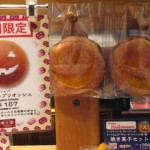


piroshki (a Russian deep-fried bun stuffed with meat), a hot dog baked around sausages, small-size pizza, varieties of Danish pastries, melon bread (the name comes from the shape and color of the bun; a very fluffy bread), azuki bean paste stuffed bread, an animal-face bun, a very normal-looking French baguette and a seasonal Halloween pan. Among all of these was one very unique all-in-one stuffed pan. It was a cupcake-shaped pastry with hole inside filled with bacon and egg salad. Harold was especially curious about this pan, so we purchased it for a taste and further investigation. Here are the photos of the bread and our dissection.
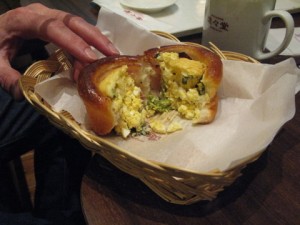
What we found inside after cutting the pan into two was bacon (not very thoroughly cooked by American standards, but in the way favored by the Japanese) and an egg preparation consisting of hardboiled chopped egg salad mixed with spinach). What a wonderful breakfast idea – a complete bacon, egg and bread meal in a single bun.
Posted
on 12:10 AM
in Hiroko's Blog
Soba is always my preferred choice for a light and satisfying lunch. Which soba restaurant I choose in the physically huge city of Tokyo depends on where I will be at lunch time. Today’s lunch was at Nanaki in Ebisu (3 minutes walk from JR Ebisu station) because I was visiting my mom. My mom, who lives in the neighborhood, took me there some years ago. Since then Nanaki has been one of my favorites.
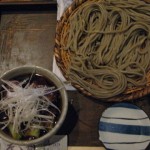
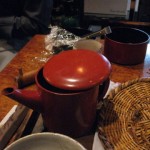
The inside of the restaurant has an antique look or in a straightforward way, no charm; well used very basic, no fringes dark colored tables and chairs darkened by age in an already dark room; no air-conditioning during hot and humid summer. Nanaki restaurant specializes soba from Togakushi in Nagano-Prefecture (the Winter Olympics was held in this area several years ago). Their noodles are known as thick, rough textured and with very good soba flavor. I ordered Kamo-nanban zaru soba – cold soba placed on a bamboo tray served with hot broth with sliced duck breast and Japanese naganegi long green onion in it. The very hot liquid in which soba is cooked (sobayu) is served in a red lacuquerware pot with long beak. It is a wonderful way to finish a soba meal with sobayu. This is how I do it: Pour some sobayu into a tea cup (ask the server) and flavor it with little remaining soba broth. In this way you do not finish all the remaining soba broth because the broth is very high in salt content becasue of its shoyu base. If you drink all of the broth you are consuming too much salt in one meal.
Soba is also seasonal like other produce or rice. The buckwheat berry is harvested during mid-September. Soba flour made from this harvest (now it is the time to enjoy it!) produces the most savory, wonderful tasting noodles. If you happen to be in Japan, enjoy the special treat! Hiroko, Tokyo
Posted
on 7:41 PM
in Hiroko's Blog
Today after meetings I stopped and shopped forsome healthy, easy-to-prepare food items at the famous Ginza Mitsukoshi Department Store food court. I wanted to buy some nourishing tretats for my mom who just returned to her home after one month hospitalization. On my way out of the store to the subway entrance I passed a butcher which had an unusual display case of beef (the photo below).
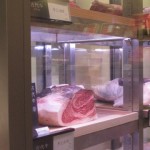

Out of curiosity I stopped and stared at each of the large blocks of beef in the case, then noticed the brand name of the products and their prices. The brand name is Kodai-gyu , the direct translation of which is ancient beef. I have never before heard of such a product. Catching my confused facial expression a young sales woman, and then, the president of the company, Mr. Kojima, who happened to be working behind the sales counter on that day approached and explained to me the story of this very special beef.
In ancient Japan cows were not raised for consumption, but were important work animals on the farm. So, farmers raised these valuable and very useful animals with care, much love and natural feed. Mr. Kojima believes that the best tasting beef comes from cows raised in this traditional manner. So, this is how farmers raise cows for Mr. Kojima. After the calf is born, it is kept with mother for half a year. During this period the calf is mostly fed with mother’s milk, her love and some rice straw and grasses. Mr. Kojima emphasized that mother’s milk contribute to two important factors – It reduces the chances of calf’s sickness and provides great satisfaction and much less stress to the calf – both contribute to producing cows that are both mentally and physically healthy. This is the secret of delicious beef, Mr. Kojima said. After half a year, calf is fed with natural feed – rice straw, field grasses along with some mixed grains.
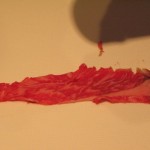
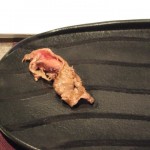
Another secret of this Kodai-gyu, is that it is aged. According to Mr. Kojima dressed beef is cleaned and aged whole for four weeks in a cold walk-in; then cut into blocks and further aged in a temperature and humidity controlled, air-circulating glass case. I was amazed to see the aged beef surrounded by snow white fat. Aging did not turn it to yellow. Komima-san sliced a thin piece from a large block, lightly salted and quickly cooked it in a skillet for me to taste. The above photo shows the raw slice and the other, the cooked one. When I slowly bit into the piping hot slice, sweetness and noticeable good “flavor” exploded in my mouth. I have never tasted such a clean, flavorful meat. Mr. Kojima has a dream to introduce this delicious beef raised in a humane environment and aged with care to a world-wide audience. Visit www.kojima-shoten.com.
Posted
on 4:02 AM
in Hiroko's Blog
I have produced sushi video episodes for About.com. The producer Heidi Dehncke was a wonderful person to work with.
Please check out the below links to learn how to cut avocado and carrot for sushi; how to make nigirizushi; how to make inside out crab roll; how to make sashimi! Also visit About.com for additional episodes.
https://video.about.com/japanesefood/How-to-Cut-Avocado-for-Sushi.htm
https://video.about.com/japanesefood/How-to-Make-Nigiri.htm
https://video.about.com/japanesefood/How-to-Cut-Cucumber-for-Sushi.htm
https://video.about.com/japanesefood/How-to-Cut-Carrots-for-Sushi.htm
Thank you! Hiroko
Thank you!
Posted
on 4:13 PM
in Hiroko's Blog
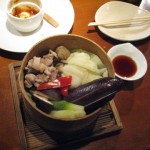
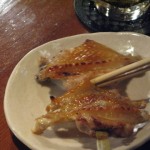


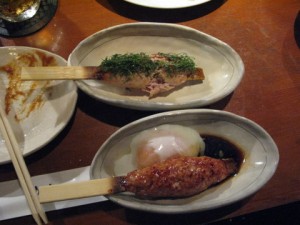
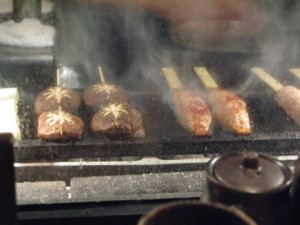 Here are some of the photos from our delicious yakitori dinner at Hinai-ya last night. One skewer of yakitori costs about $4.50 per skewer. So, It is not a cheap meal. However, the quality is superb and you get what you pay for it. The Hinai-ya restaurants are among many other restaurants which closely stands next each other in the narrow Ginza Corridor street (people call it “restaurant street”).
Here are some of the photos from our delicious yakitori dinner at Hinai-ya last night. One skewer of yakitori costs about $4.50 per skewer. So, It is not a cheap meal. However, the quality is superb and you get what you pay for it. The Hinai-ya restaurants are among many other restaurants which closely stands next each other in the narrow Ginza Corridor street (people call it “restaurant street”).
If you like an inexpensive yakitori treat, there is a new-comer, casual and lively Yakitori bar restaurant where you stand and eat (similar to tapas bar in Spain). Most of the yakitori at this bar is priced at $1 per skewer. How can they do it so cheap? The restaurant uses pre-prepared, frozen chicken (chicken was cut into pieces and placed on Yakitori skewers) comes from Thailand or other Asian country. It is NOT special Hinai chicken which is delivered refrigerated to Hinai-ya restaurant just after slaughter, and processed – de-boned, cut into pieces and properly put on skewers – under Hinai-ya’s experienced chef’s supervision. Well, saying that $1 per skewer Yakitori is not so bad. After stressed office work hours, there needs to be inexpensive places for ordinary Japanese business people where they can meet up, loosen up their pent up stress and enjoy after work hours with glasses of beer, sake or shochu with decent good food.
Sotry continues…..from Tokyo.
Posted
on 6:45 AM
in Hiroko's Blog
I have checked into my favorite hotel, the Daiichi Hotel Annex, in Tokyo. The Daiichi Hotel Annex is an inexpensive creation of the more ornate main hotel, the Daiichi Hotel, which stands next to this building. The merit is that for a low price – about $200 per night, you can take advantage of all of the facilites of a four star hotel costing $400+ per night. The average double occupancy room at this hotel is 250 square foot; very clean, neat and modern. The best thing about this hotel is the location. It is a three minutes walk (more…)
Posted
on 9:18 AM
in Hiroko's Blog
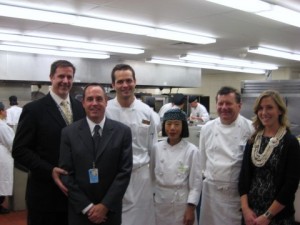
Please check out the clip. It was fun and hell at the same time. I will be leaving for Japan on Sunday 3rd for three weeks. I will post blogs through my jorney. Hiroko
Posted
on 5:32 PM
in Hiroko's Blog
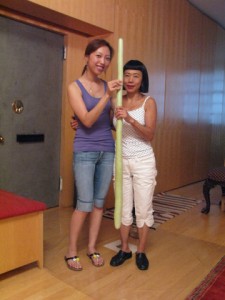
My chef assistant Anna Yeung one day stopped by Hiroko’s Kitchen with an immensely long vegetable which I have never seen in my life. According to Anna, her father purchased cucuzza plants which were about 5 inches tall from Whitestone Nursery in Queens sometime during the first week of June this year. After carrying the plants back to his home he dug six circles into his garden about a food apart from each other and planted them. Fortunately, all plants grew tall. The cucuzza plant needs plenty water so this became her father’s job over the summer. He was careful not to forget to water them every day. Anna’s father knows when to harvest the vegetable. The cucuzza should have light green color on the skin. This means that the skin is paper thin and flesh is moist and tender with no seeds. When the vegetable starts to bear whitish spots on the skin, it is a sign that the skin is getting tougher and the flesh becoming seedy. Anna’s family harvested about 10 of these immense cucuzza squash.
In this picture you can see how long the cucuzza grew! That night I sauteed cucuzza in a skillet with a little olive oil, shoyu, and sea salt. It had a very clean, refreshing taste, perfect for the hot evening. Thank you, Anna for introducing me to a new vegetable. And, we continued to enjoy the vegetable for many nights after that.
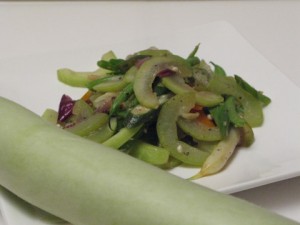
Anna said that this is an Italian vegetable, but I was not sure if it was until two days ago when I visited for the first time Mario Batali’s new creation, EATALY supermarket and restaurants (jammed with customers) in Chealsea and there I spotted cucuzza! But they were much shorter and less fresh looking than the gift I received from Anna and her father. Personal and continuous care is necessary to produce a squash like the one I received from Anna. Besides, there would be no room to store and display monster squash like the one I received.
Posted
on 2:13 PM
in Hiroko's Blog
Hiroko’s Essential Japanese Cooking Courseis running next year at International Culinary Center (ICC)/ French Culinary Institute (FCI)! Anyone who wishes to learn the art of Japanese cooking to a thorough extent should join my Essential Japanese Cookuign Course at ICC/FCI in New York in July and October, 2011. The course consists of five consecutive days of classes. (more…)
 Hiroko’s Kitchen made it onto CulinaryPrograms.net’s recently completed list of 100 Magnificent Sites for Chefs.
Hiroko’s Kitchen made it onto CulinaryPrograms.net’s recently completed list of 100 Magnificent Sites for Chefs.



















